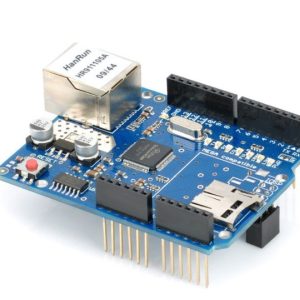Popis
Informačná stránka o senzore MQ-8 Hydrogen Gas Sensor
| Popis | Senzor MQ-8 je modul detektora vodíka, ktorý sa používa na detekciu prítomnosti vodíka vo vzduchu. |
|---|---|
| Vlastnosti |
|
| Parametre |
|
| ESPHome konfigurácia |
sensor:
- platform: adc
pin: A0
name: "Koncentrácia vodíka"
update_interval: 60s
filters:
- calibrate_linear:
- 0.0 -> 0.0
- 1023.0 -> 10000.0 # Predpokladajme, že 1023 je maximálna hodnota ADC a 10000 je maximálna koncentrácia
|
| Príkladový kód pre Arduino |
#define ANALOG_PIN A0 // Analógový pin pre senzor
void setup() {
Serial.begin(9600);
}
void loop() {
int hodnotaSenzora = analogRead(ANALOG_PIN);
float koncentráciaVodíka = map(hodnotaSenzora, 0, 1023, 0, 10000); // Mapovanie hodnoty senzora na koncentráciu (predpokladajme, že 1023 je maximálna hodnota ADC a 10000 je maximálna koncentrácia)
Serial.print("Koncentrácia vodíka: ");
Serial.println(koncentráciaVodíka);
delay(1000); // Prispôsobte oneskorenie podľa potreby
}
|
Informačná stránka o senzore MQ-8
| Popis | Senzor MQ-8 je modul detektora vodíka, ktorý je schopný detekovať prítomnosť vodíka v ovzduší. |
|---|---|
| Vlastnosti |
|
| Špecifikácie |
|
| Príklady použitia | Senzor MQ-8 sa často používa na detekciu vodíka v rôznych prostrediach, ako sú priemyselné prevádzky, skladovacie priestory a laboratóriá. |
| Príkladový kód pre Arduino |
// Importovanie knižnice pre senzor MQ-8
#include <MQ8.h>
// Definícia pinu
int pinA0 = A0; // Analógový pin
// Inicializácia senzora
MQ8 mq8(pinA0);
void setup() {
Serial.begin(9600); // Inicializácia komunikácie sériového portu
}
void loop() {
// Čítanie hodnôt z senzora
float ppm = mq8.read();
// Vypísanie hodnôt na sériový port
Serial.print("Hodnota vodíka (PPM): ");
Serial.println(ppm);
delay(1000); // Čakanie 1 sekundu
}
|
| Príkladový kód pre ESPHome |
# Example configuration entry
sensor:
- platform: adc
pin: A0
name: "Hydrogen Sensor"
update_interval: 30s
filters:
- lambda: return (pow(10, log10((0.12/x)*(5-x)/(5-0.12))/(-0.35)))
unit_of_measurement: "ppm"
|
MQ8 Senzor vodíka H2 Detekčný senzor
Vstupné napätie: DC 5V
Prúd: 150mA
Výstup DO: TTL 0 a 1 (0,1 a 5 V)
AO výstup: 0,1 – 0,3V
Kryštály: 11,0592 MHz
Prenosová rýchlosť: 9600
Vlastnosti modulu:
Vysoko kvalitný dizajn s dvojitým panelom s indikátormi napájania a pokynmi na výstup signálu TTL
Výstup TTL a výstup analógového signálu AO
Štyri otvory pre skrutky uľahčujúce polohovanie
Funkcie obnovy rýchlej odozvy
Stabilita dlhej životnosti a spoľahlivosť
Veľkosť: 35 * 23 * 27 mm / 1,37 * 0,9 * 1,06 ”
Modul snímača vodíka/H2 MQ-8
Prehľad
Tento senzorový modul má MQ-8 ako senzorový komponent a má zabudovaný ochranný odpor a nastaviteľný odpor. Plynový senzor MQ-8 je vysoko citlivý na vodík a menej citlivý na alkohol a výpary z varenia. Mohol by byť použitý v zariadeniach na detekciu úniku plynu v rodine a priemysle. Odpor citlivej zložky sa mení so zmenou koncentrácie cieľového plynu.
Vlastnosti
Nepretržitý analógový výstup
3-pinový blokovací konektor
Nízka cena a kompaktná veľkosť

Standard Working Condition
| Symbol | Parameter Name | Technical Condition | Remarks |
| VC | Circuit voltage | 5V±0.1 | AC or DC |
| VH | Heating voltage | 5V±0.1 | AC or DC |
| RL | Load resistance | 10Kohm | |
| RH | Heater resistance | 31Kohm±5% | Room temperature |
| PH | Heating consumption | Less than 800mW |
Environment Condition
| Symbol | Parameter Name | Technical Condition | Remarks |
| TO | Operating Temp. | -10°C-50°C | |
| TS | Storage Temp. | -20°C-70°C | |
| RH | Relative Humidity | <95% | |
| O2 | Oxygen Concentration | 21%(standard condition) Oxygen concentration can affect sensitivity | Minimum value is 2% |
Sensitivity Characteristics
| Symbol | Parameter Name | Technical Condition | Remarks |
| RS | Sensor Resistance | 10Kohm-60Kohm (1000ppm LPG) | Detecting concentration Scope: 100-10000ppm H2 |
| α (1000ppm/4000ppm H2) | Concentration slope rate | ≤0.6 | |
| Standard detecting Condition | Temp.: 20°C±2°C VC: 5V±0.1 Humidity:65%±5% VH:5V±0.1 |
||
| Preheating Time | Over 24 hours | ||


/*******************Demo for MQ-8 Gas Sensor Module V1.0*****************************
Contact: support[at]sandboxelectronics.com
Lisence: Attribution-NonCommercial-ShareAlike 3.0 Unported (CC BY-NC-SA 3.0)
Note: This piece of source code is supposed to be used as a demostration ONLY. More
sophisticated calibration is required for industrial field application.
Sandbox Electronics 2014-02-03
************************************************************************************/
/************************Hardware Related Macros************************************/
#define MQ_PIN (0) //define which analog input channel you are going to use
#define RL_VALUE (10) //define the load resistance on the board, in kilo ohms
#define RO_CLEAN_AIR_FACTOR (9.21) //RO_CLEAR_AIR_FACTOR=(Sensor resistance in clean air)/RO,
//which is derived from the chart in datasheet
/***********************Software Related Macros************************************/
#define CALIBARAION_SAMPLE_TIMES (50) //define how many samples you are going to take in the calibration phase
#define CALIBRATION_SAMPLE_INTERVAL (500) //define the time interal(in milisecond) between each samples in the
//cablibration phase
#define READ_SAMPLE_INTERVAL (50) //define how many samples you are going to take in normal operation
#define READ_SAMPLE_TIMES (5) //define the time interal(in milisecond) between each samples in
//normal operation
/**********************Application Related Macros**********************************/
#define GAS_H2 (0)
/*****************************Globals***********************************************/
float H2Curve[3] = {2.3, 0.93,-1.44}; //two points are taken from the curve in datasheet.
//with these two points, a line is formed which is “approximately equivalent”
//to the original curve.
//data format:{ x, y, slope}; point1: (lg200, lg8.5), point2: (lg10000, lg0.03)
float Ro = 10; //Ro is initialized to 10 kilo ohms
void setup()
{
Serial.begin(9600); //UART setup, baudrate = 9600bps
Serial.print(“Calibrating…\n”);
Ro = MQCalibration(MQ_PIN); //Calibrating the sensor. Please make sure the sensor is in clean air
//when you perform the calibration
Serial.print(“Calibration is done…\n”);
Serial.print(“Ro=”);
Serial.print(Ro);
Serial.print(“kohm”);
Serial.print(“\n”);
}
void loop()
{
Serial.print(“H2:”);
Serial.print(MQGetGasPercentage(MQRead(MQ_PIN)/Ro,GAS_H2) );
Serial.print( “ppm” );
Serial.print(“\n”);
delay(200);
}
/****************** MQResistanceCalculation ****************************************
Input: raw_adc – raw value read from adc, which represents the voltage
Output: the calculated sensor resistance
Remarks: The sensor and the load resistor forms a voltage divider. Given the voltage
across the load resistor and its resistance, the resistance of the sensor
could be derived.
************************************************************************************/
float MQResistanceCalculation(int raw_adc)
{
return ( ((float)RL_VALUE*(1023-raw_adc)/raw_adc));
}
/***************************** MQCalibration ****************************************
Input: mq_pin – analog channel
Output: Ro of the sensor
Remarks: This function assumes that the sensor is in clean air. It use
MQResistanceCalculation to calculates the sensor resistance in clean air
and then divides it with RO_CLEAN_AIR_FACTOR. RO_CLEAN_AIR_FACTOR is about
10, which differs slightly between different sensors.
************************************************************************************/
float MQCalibration(int mq_pin)
{
int i;
float val=0;
for (i=0;i<CALIBARAION_SAMPLE_TIMES;i++) { //take multiple samples
val += MQResistanceCalculation(analogRead(mq_pin));
delay(CALIBRATION_SAMPLE_INTERVAL);
}
val = val/CALIBARAION_SAMPLE_TIMES; //calculate the average value
val = val/RO_CLEAN_AIR_FACTOR; //divided by RO_CLEAN_AIR_FACTOR yields the Ro
//according to the chart in the datasheet
return val;
}
/***************************** MQRead *********************************************
Input: mq_pin – analog channel
Output: Rs of the sensor
Remarks: This function use MQResistanceCalculation to caculate the sensor resistenc (Rs).
The Rs changes as the sensor is in the different consentration of the target
gas. The sample times and the time interval between samples could be configured
by changing the definition of the macros.
************************************************************************************/
float MQRead(int mq_pin)
{
int i;
float rs=0;
for (i=0;i<READ_SAMPLE_TIMES;i++) {
rs += MQResistanceCalculation(analogRead(mq_pin));
delay(READ_SAMPLE_INTERVAL);
}
rs = rs/READ_SAMPLE_TIMES;
return rs;
}
/***************************** MQGetGasPercentage **********************************
Input: rs_ro_ratio – Rs divided by Ro
gas_id – target gas type
Output: ppm of the target gas
Remarks: This function passes different curves to the MQGetPercentage function which
calculates the ppm (parts per million) of the target gas.
************************************************************************************/
int MQGetGasPercentage(float rs_ro_ratio, int gas_id)
{
if ( gas_id == GAS_H2) {
return MQGetPercentage(rs_ro_ratio,H2Curve);
}
return 0;
}
/***************************** MQGetPercentage **********************************
Input: rs_ro_ratio – Rs divided by Ro
pcurve – pointer to the curve of the target gas
Output: ppm of the target gas
Remarks: By using the slope and a point of the line. The x(logarithmic value of ppm)
of the line could be derived if y(rs_ro_ratio) is provided. As it is a
logarithmic coordinate, power of 10 is used to convert the result to non-logarithmic
value.
************************************************************************************/
int MQGetPercentage(float rs_ro_ratio, float *pcurve)
{
return (pow(10,( ((log(rs_ro_ratio)-pcurve[1])/pcurve[2]) + pcurve[0])));
}





